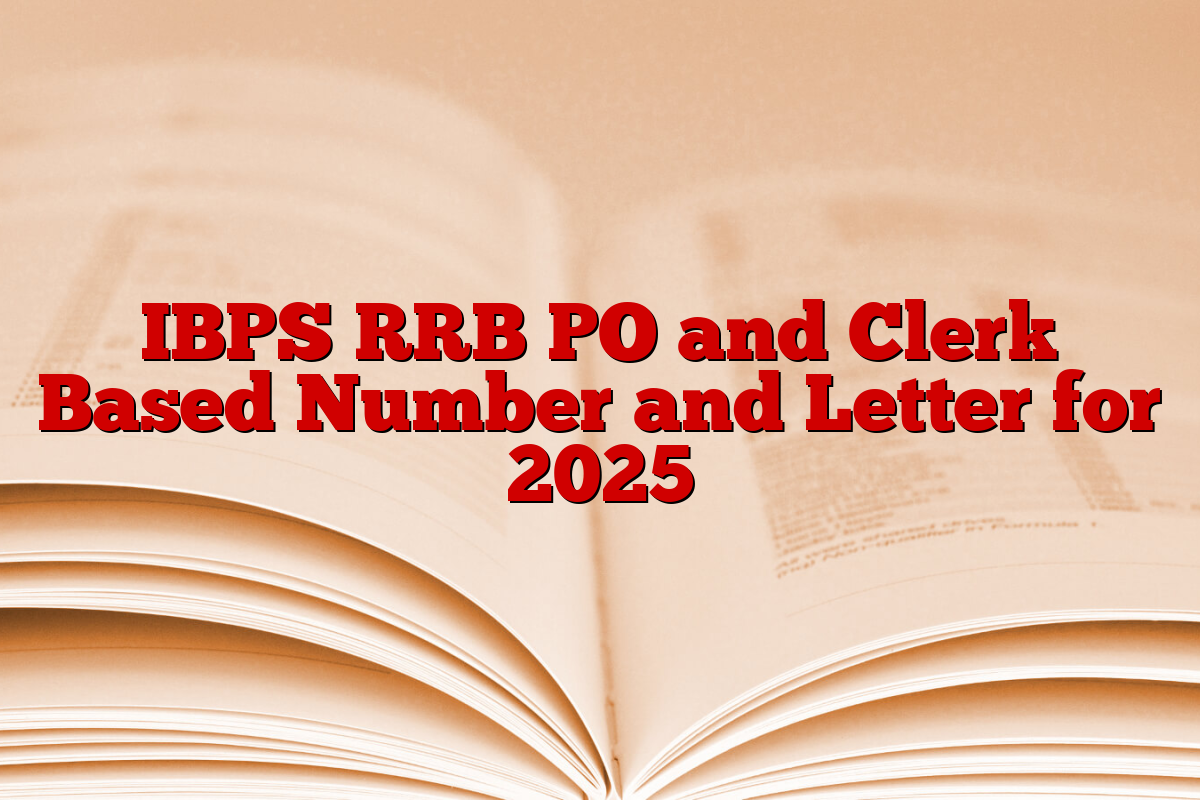Number and letter-based questions are an important part of the logic capacity section in competitive examinations like IBPS RRB PO and Clerk 2025. These questions test the ability of a candidate to identify patterns, sequences and logical connections in combination with numbers, letters, or both, often requires quick thinking and fast observation skills.
IBPS RRB PO and Clerk Based Number and Letter for 2025
IBPS RRB PO and Clerk is one of the major scoring subjects, in the logic section of 2025 exam Number and letter-based questionsThis subject holds important importance as it often appears in the examination and tested a candidate’s ability to identify the pattern and logical sequences including a mixture of number, letters, or both. With the right strategy and regular practice, candidates can resolve these questions quickly and accurately, making it a necessary subject to focus during preparation.
What are the numbers and letters-based questions?
These questions include the sequence or arrangement of a combination of numbers, letters, or both. You need to identify the pattern that controls the sequence and then answer the question based on that pattern. Questions can be in different formats, such as:
- Finding next term: You are given a sequence, and you need to determine the latter number, letter or alphanumeric combination.
- Identifying the word missing: A word is missing from sequence, and you need to find it.
- Finding the wrong word: A conditions in the sequence do not follow the installed pattern, and you need to identify it.
- Based on a given system: You may be given a series of number, letter, or both, and the questions will ask you to find elements based on certain conditions (eg: how many numbers are there before and after a symbol).
Types of number and letter based series:
-
Number series: These series include a sequence of numbers after a specific rule, which may be based on:
- Arithmetic operations (moreover, subtraction, multiplication, division).
- Classes, cubes, or their variations.
- Prime numbers.
- Combination of these functions.
- Pattern of differences between frequent words.
- Example: 2, 4, 8, 16 ,? (Pattern: Multiplicate by 2. Answer: 32)
-
Letter series: These chains have a sequence of letters after a pattern based on their alphabet sequence. The pattern may include:
- Leave a certain number of letters.
- Moving forward or backwards in the alphabet.
- Using reverse alphabet sequence.
- Example: A, C, E, G,? (Pattern: Leave a letter. Answer: i)
-
Alphonumeric series: This chain is a mixture of systematic letters, numbers and sometimes symbols in a specific order. You need to identify the underlying pattern that controls both the alphabet and numerical parts of the sequence.
- Example: A3%, D9G, @5B,?
How to prepare these questions:
-
Understand the basics: A familiarity with the English alphabet order and basic arithmetic operations. Knowing squares, cubes and prime numbers to a certain extent can also be helpful for the number chain.
-
Practice pattern recognition: The key to solving these questions is to recognize the pattern quickly. Practice different types of chains to develop this skill. Look for a normal pattern such as continuous difference/ratio, increasing/decreasing difference/ratio, and combinations.
-
Break down alphanumeric series: For alphasomeric chain, try separately analysis of letters and number parts. Sometimes, patterns in letters and numbers can be independent of each other.
-
Note carefully: For questions based on a given arrangement, pay full attention to the posts mentioned in the question (left, right, end to left, right,).
-
Time Management: These questions are usually scoring if you can identify the pattern quickly. Practice to solve them within a time limit to improve your speed.
Number and letter based series questions:
Instructions (01-05): These questions are based on the following alphabet and series of digits.
D 5 pkl 8 zmci 6 oque 1 tnr 4 gba 9 Fsw 2 hjv 7 yx 3
Q01. How many marks are there in the above arrangement that is immediately followed by one tone?
(Two
(b) Four
(c) One
(d) three
(e) no one
Q02If all the vowels are removed from the above arrangement, which of the following letters/digits is from 10th to 10th or 5th position from the right end?
(A) R
(b) ४
(c) G
(d) 9
(e) None of these
Q03. Which of the following letters/digits is from right to right from 7th to right?
(A) A
(b) 2
(c) h
(d) 9
(e) None of these
Q04How many dishes are there in the above arrangement that are immediately before a dish and immediately occur after one tone?
(A) four
(b) three
(c) Two
(Done
(e) no one
Q05Which of the following elements is between ‘B’ and ‘2’ in the provided system?
(a) 9
(b) f
(c) s
(d) W
(e) None of these
Q06. How many couples are there in the word “enough”, each of which has as many letters among them as they are among them in the English alphabet?
(a) three
(Bone
(c) Two
(d) More than three
(e) no one
Q07. If in the number ‘63143214’, after multiplying by 2 to 2 in each odd digit, in addition to 1 and 3 in each digit after multiplying 3 in each digit, after reducing 3, how many digits are being repeated in the new number?
(a) three
(Bone
(c) None
(d) two
(e) Four
Q08. Which of the following elements should come in place of “”? ,
JQ4 HS9 FU16?
(A) EV36
(b) PK 81
(C) IR 100
(d) DW25
(e) ४ ९
Q09. Arun is ranked 38th from top and 44th from below in one class. How many students are there in class?
(a) 82
(b) 77
(c) 81
(d) 79
(e) None of these
Q10. If the number ‘867351429’, all digits are arranged in the new arrangement in the new system in the same place in order to grow from right to left?
(a) three
(b) Four
(c) None
(d) two
(e) one
